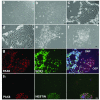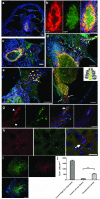Restoration of auditory evoked responses by human ES-cell-derived otic progenitors
- PMID: 22972191
- PMCID: PMC3480718
- DOI: 10.1038/nature11415
Restoration of auditory evoked responses by human ES-cell-derived otic progenitors
Abstract
Deafness is a condition with a high prevalence worldwide, produced primarily by the loss of the sensory hair cells and their associated spiral ganglion neurons (SGNs). Of all the forms of deafness, auditory neuropathy is of particular concern. This condition, defined primarily by damage to the SGNs with relative preservation of the hair cells, is responsible for a substantial proportion of patients with hearing impairment. Although the loss of hair cells can be circumvented partially by a cochlear implant, no routine treatment is available for sensory neuron loss, as poor innervation limits the prospective performance of an implant. Using stem cells to recover the damaged sensory circuitry is a potential therapeutic strategy. Here we present a protocol to induce differentiation from human embryonic stem cells (hESCs) using signals involved in the initial specification of the otic placode. We obtained two types of otic progenitors able to differentiate in vitro into hair-cell-like cells and auditory neurons that display expected electrophysiological properties. Moreover, when transplanted into an auditory neuropathy model, otic neuroprogenitors engraft, differentiate and significantly improve auditory-evoked response thresholds. These results should stimulate further research into the development of a cell-based therapy for deafness.
Figures




Comment in
-
Human stem cells ameliorate auditory evoked responses in a model of neuropathy.Stem Cell Res Ther. 2012 Nov 8;3(6):44. doi: 10.1186/scrt135. Stem Cell Res Ther. 2012. PMID: 23134736 Free PMC article.
References
-
- Vlastarakos PV, Nikolopoulos TP, Tavoulari E, Papacharalambous G, Korres S. Auditory neuropathy: endocochlear lesion or temporal processing impairment? Implications for diagnosis and management. International journal of pediatric otorhinolaryngology. 2008;72:1135–1150. - PubMed
-
- Uus K, Bamford J. Effectiveness of population-based newborn hearing screening in England: ages of interventions and profile of cases. Pediatrics. 2006;117:e887–893. - PubMed
-
- Bradley J, Beale T, Graham J, Bell M. Variable long-term outcomes from cochlear implantation in children with hypoplastic auditory nerves. Cochlear implants international. 2008;9:34–60. - PubMed
-
- Li H, Liu H, Heller S. Pluripotent stem cells from the adult mouse inner ear. Nat Med. 2003;9:1293–1299. - PubMed
Publication types
MeSH terms
Substances
Associated data
- Actions
Grants and funding
LinkOut - more resources
Full Text Sources
Other Literature Sources
Medical
Molecular Biology Databases

